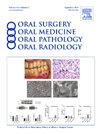The efficacy of CBCT-based radiomics techniques in differentiating between conventional and unicystic ameloblastoma
IF 2
3区 医学
Q2 DENTISTRY, ORAL SURGERY & MEDICINE
Oral Surgery Oral Medicine Oral Pathology Oral Radiology
Pub Date : 2024-06-24
DOI:10.1016/j.oooo.2024.06.010
引用次数: 0
Abstract
Objective
The aim of this study was to develop a cone beam computed tomography (CBCT) radiomics-based model that differentiates between conventional and unicystic ameloblastoma (AB).
Methods
In this retrospective study, CBCT images were collected from 100 patients who had ABs that were diagnosed histopathologically as conventional or unicystic AB after surgical treatment. The patients were randomly divided into training (70) and validation (30) cohorts. Radiomics features were extracted from the images, and the optimal features were incorporated into 5 models: Logistic Regression, Support Vector Machine, Linear Discriminant Analysis, Random Forest, and XGBoost for prediction of tumor type. Model performance was evaluated using the area under the curve (AUC) from receiver operating characteristic analysis, sensitivity, specificity, accuracy, calibration curves, and decision curve analysis (DCA).
Results
The 20 optimal radiomics features were incorporated into the Logistic Regression (LR) model, which exhibited the best overall performance with AUC = 0.936 (95% confidence interval [CI] = 0.877-0.996) for the training cohort and AUC = 0.929 (95% CI = 0.832-1.000) for the validation cohort. The nomogram combined the clinical features and the radiomics signature and resulted in the best predictive performance.
Conclusions
The LR model demonstrated the ability of radiomics and the nomogram to distinguish between the 2 types of AB and may have the potential to replace biopsies under noninvasive conditions.
基于 CBCT 的放射组学技术在区分传统釉母细胞瘤和单囊釉母细胞瘤方面的功效。
目的:本研究旨在开发一种基于锥形束计算机断层扫描(CBCT)的放射组学模型,以区分常规和单囊釉母细胞瘤(AB):本研究旨在开发一种基于锥形束计算机断层扫描(CBCT)放射组学的模型,以区分传统型和单囊型母细胞瘤(AB):在这项回顾性研究中,研究人员收集了100名AB患者的CBCT图像,这些患者在手术治疗后经组织病理学诊断为传统型或单囊型AB。这些患者被随机分为训练组(70 人)和验证组(30 人)。从图像中提取放射组学特征,并将最佳特征纳入 5 个模型:逻辑回归模型、支持向量机模型、线性判别分析模型、随机森林模型和 XGBoost 模型用于预测肿瘤类型。使用接收者操作特征分析的曲线下面积(AUC)、灵敏度、特异性、准确性、校准曲线和决策曲线分析(DCA)对模型性能进行评估:训练队列的 AUC = 0.936(95% 置信区间 [CI] = 0.877-0.996),验证队列的 AUC = 0.929(95% 置信区间 [CI] = 0.832-1.000)。提名图结合了临床特征和放射组学特征,具有最佳预测效果:LR模型证明了放射组学和提名图区分2种类型AB的能力,并有可能在无创条件下取代活检。
本文章由计算机程序翻译,如有差异,请以英文原文为准。
求助全文
约1分钟内获得全文
求助全文
来源期刊

Oral Surgery Oral Medicine Oral Pathology Oral Radiology
DENTISTRY, ORAL SURGERY & MEDICINE-
CiteScore
3.80
自引率
6.90%
发文量
1217
审稿时长
2-4 weeks
期刊介绍:
Oral Surgery, Oral Medicine, Oral Pathology and Oral Radiology is required reading for anyone in the fields of oral surgery, oral medicine, oral pathology, oral radiology or advanced general practice dentistry. It is the only major dental journal that provides a practical and complete overview of the medical and surgical techniques of dental practice in four areas. Topics covered include such current issues as dental implants, treatment of HIV-infected patients, and evaluation and treatment of TMJ disorders. The official publication for nine societies, the Journal is recommended for initial purchase in the Brandon Hill study, Selected List of Books and Journals for the Small Medical Library.
 求助内容:
求助内容: 应助结果提醒方式:
应助结果提醒方式:


